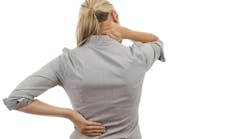It’s widely accepted that being strong is associated with being healthy, but what many don’t know is that muscle is considered “the longevity organ” of the body. Hygienists are especially in danger of losing the battle with maintaining the health and independence that organ provides.
If we want to maintain the ability to practice hygiene, reduce body pain from poor posture, lift a grocery bag off of the counter, push ourselves off of the couch, reduce our all-cause mortality fall risk, or hold that deliciously full cup of coffee/tea without dropping it, we have to address the role that muscle mass plays in longevity.
Grip strength
Scientifically speaking, studies show that a majority of hygienists report body pain,1 with at least 40% of us reporting symptoms of hand and wrist conditions (e.g., carpal tunnel syndrome) that lead to grip-strength loss.2 Another study shows that 44% of hygienists experience long-term accumulation of hand paresthesia, contributing to grip-strength reduction.3 Grip-strength decline has been linked to an increased risk of mobility problems, falls, metabolic disorders, decreased life expectancy, and even reduced mental capacity.4,5 Without it, we cannot practice safely, but not being able to hold a scaler is not the only problem we face with losing grip strength. Grip strength is the manifestation of the bigger, more volcanic problem of overall loss of muscle mass (sarcopenia).
Sarcopenia is a common by-product of age. The average adult loses 3%–5% of muscle mass each decade after the age of 30.6 With that loss comes a barrage of longevity-impacting issues from poor posture, increased fall risk—the top cause for injury-related mortality for older adults7—osteoporosis, insulin resistance (muscle is where insulin receptors are housed in the body), lack of mobility, and weight management problems.8 Overall muscle mass loss is the problem when tasks such as opening a jar, holding a shampoo bottle in one hand, pulling pants up, or pushing a vacuum become difficult.
Why hygienists?
Hygienists are at risk due to the nature of our jobs that often involves an awkward, static, predominantly seated posture. This can cause chronic fatigue, poor hydration, elevated cortisol levels from stress, and hand/wrist injury that results in decreased grip strength. We also see the significant impact that dexterity reduction plays in the oral conditions of our patients that may eventually affect us.9
Am I at risk?
Luckily, we can easily determine our risk levels. Peter Attia, MD, and longevity expert, recommends that for reasonable grip strength, women should be able to carry at least 75% of their body weight for at least one minute, while men should be able to carry 100% of their weight. Grab some weight (kettle bells, dumbbells, etc.) and time yourself. If you fall short of a minute, keep practicing daily, adding more weight until you reach your goal. Another tool is a handgrip dynamometer, which sounds more complicated than it is and comes with charts/instructions that show if your grip strength is optimal.
Grip strength is so integrated with generalized muscle mass that by increasing overall strength, grip strength automatically improves. Even better, grip-strength development isn’t complicated, and a gym membership isn’t required. It can be broken down into a few general nuggets of information.
What we don’t use, we lose. The older we get, the harder it becomes to get off the floor—mostly because we simply stop performing the task. The core, chest, shoulders, back, and hip musculature atrophies, tendons and fascia become stiff, and we lose the ability. Solution: get down onto the floor every day, even if only for a few minutes, so that the strength required to get back up is maintained. It doesn’t matter how getting up occurs, just that it does.
You are what you eat. Skeletal muscle makes up 40% of the body and holds 50%–75% of its proteins.10 If you want to maintain muscle, you must consume protein. Approximately one gram of protein per pound of body weight is recommended daily to maintain and repair existing muscle; more for growth.11 Don’t worry, getting protein is easier than we think. It’s found in yogurt, eggs, meats, fish, and protein bars or powders (plant- or animal-based). Exercising till the cows come home won’t grow muscle until you provide the protein required for synthesis.
Mud is required. Eating all the protein in the house won’t grow muscle unless resistance also happens. Muscle growth for strength is different than routine repair from regular daily activity. The way muscle fibers grow is by the fibers tearing apart from contraction overload, called failure, and then mending back in multiples with amino acid proteins from our diet. Muscles must get to failure (at least a little) to rebuild bigger, and consequently, stronger. That resistance is often created with weight—bodyweight, resistance bands, or free/machine weights. It can be achieved with isometric contractions that hold until failure like a plank, or dynamic movements like a squat (or getting off the floor when that is hard), but resistance is required. Muscle-building is a lot like a lotus flower growing: mud is required.
A body in motion stays in motion. The longer we sit, the more it takes to get going again and the harder the metabolism must work to ramp back up. It doesn’t have to be fancy or take all day; it can be stretching during huddle, taking the stairs, parking a little farther away, or even a lunchtime walk around the block.
Living our lives to the fullest while maintaining independence is very possible. Determining grip strength isn’t just about holding onto a scaler. It’s a window into your overall health and how well you’re aging. So, find something heavy to carry for a long, healthy life!
References
- Gandolfi MG, Zamparini F, Spinelli A, Risi A, Prati C. Musculoskeletal disorders among Italian dentists and dental hygienists. Int J Environ Res Public Health. 2021;18(5):2705. doi:10.3390/ijerph18052705
- Anton D, Rosecrance J, Merlino L, Cook T. Prevalence of musculoskeletal symptoms and carpal tunnel syndrome among dental hygienists. Am J Ind Med. 2002;42(3):248-257. doi:10.1002/ajim.10110
- Cherniack M, Brammer AJ, Nilsson T, et al. Nerve conduction and sensorineural function in dental hygienists using high frequency ultrasound handpieces. Am J Ind Med. 2006;49(5):313-326. doi:10.1002/ajim.20288
- Kim YM, Kim S, Bae J, Kim SH, Won YJ. Association between relative hand-grip strength and chronic cardiometabolic and musculoskeletal diseases in Koreans: A cross-sectional study. Arch Gerontol Geriatr. 2021;92:104181. doi:10.1016/j.archger.2020.104181
- Rantanen T, Volpato S, Ferrucci L, Heikkinen E, Fried LP, Guralnik JM. Handgrip strength and cause-specific and total mortality in older disabled women: exploring the mechanism. J Am Geriatr Soc. 2003;51(5):636-641. doi:10.1034/j.1600-0579.2003.00207.x
- Holloszy JO. The biology of aging. Mayo Clin Proc. 2000;75 (Suppl):S3–S8.
- Web-based Injury Statistics Query and Reporting System (WISQARS). Centers for Disease Control and Prevention National Center for Injury Prevention and Control. Accessed October 23, 2023. https://www.cdc.gov/injury/wisqars/index.html
- Frontera WR, Ochala J. Sarcopenia: A critical review of the biological basis of age-related muscle loss. Eur J Translational Myol. 2015;25(1):1-10.
- Ahmad I, Togoo RA, M Alharthi DS, et al. Influence of joint flexibility, hand grip strength and pain on oral hygiene in musculoskeletal disorders-a non-interventional clinical study. J Clin Med. 2023;12(6):2190. doi:10.3390/jcm12062190
- Frontera WR, Ochala J. Skeletal muscle: a brief review of structure and function. Calcif Tissue Int. 2015;96(3):183-195. doi:10.1007/s00223-014-9915-y
- Wu G. Dietary protein intake and human health. Food Funct. 2016;7(3):1251-1265. doi:10.1039/c5fo01530h
Editor's note: This article appeared in the April/May 2025 print edition of RDH magazine. Dental hygienists in North America are eligible for a complimentary print subscription. Sign up here.
About the Author

Katrina Klein, RDH, CEAS, CPT
Katrina is an 18-year registered dental hygienist, national speaker, author, competitive bodybuilder, certified personal trainer, certified ergonomic assessment specialist, and biomechanics nerd. She’s the founder of ErgoFitLife, where she teaches that ergonomics and fitness are a lifestyle to prevent, reduce, and even eliminate workplace pain. You can reach Katrina at [email protected].


